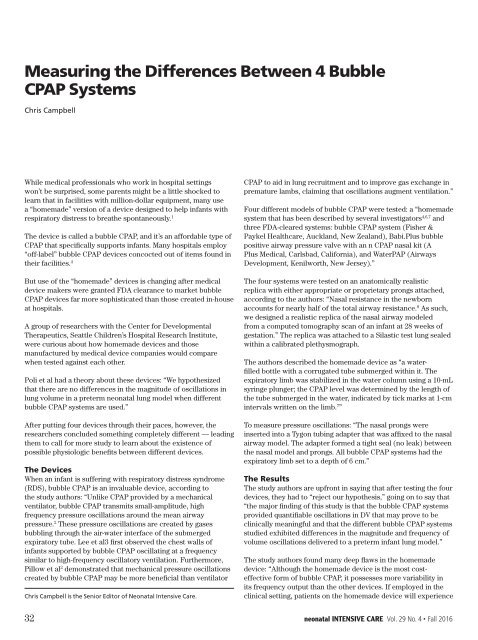INTENSIVE CARE
8dI2AMDUa
8dI2AMDUa
You also want an ePaper? Increase the reach of your titles
YUMPU automatically turns print PDFs into web optimized ePapers that Google loves.
Measuring the Differences Between 4 Bubble<br />
CPAP Systems<br />
Chris Campbell<br />
While medical professionals who work in hospital settings<br />
won’t be surprised, some parents might be a little shocked to<br />
learn that in facilities with million-dollar equipment, many use<br />
a “homemade” version of a device designed to help infants with<br />
respiratory distress to breathe spontaneously. 1<br />
The device is called a bubble CPAP, and it’s an affordable type of<br />
CPAP that specifically supports infants. Many hospitals employ<br />
“off-label” bubble CPAP devices concocted out of items found in<br />
their facilities. 4<br />
But use of the “homemade” devices is changing after medical<br />
device makers were granted FDA clearance to market bubble<br />
CPAP devices far more sophisticated than those created in-house<br />
at hospitals.<br />
A group of researchers with the Center for Developmental<br />
Therapeutics, Seattle Children’s Hospital Research Institute,<br />
were curious about how homemade devices and those<br />
manufactured by medical device companies would compare<br />
when tested against each other.<br />
Poli et al had a theory about these devices: “We hypothesized<br />
that there are no differences in the magnitude of oscillations in<br />
lung volume in a preterm neonatal lung model when different<br />
bubble CPAP systems are used.”<br />
After putting four devices through their paces, however, the<br />
researchers concluded something completely different — leading<br />
them to call for more study to learn about the existence of<br />
possible physiologic benefits between different devices.<br />
The Devices<br />
When an infant is suffering with respiratory distress syndrome<br />
(RDS), bubble CPAP is an invaluable device, according to<br />
the study authors: “Unlike CPAP provided by a mechanical<br />
ventilator, bubble CPAP transmits small-amplitude, high<br />
frequency pressure oscillations around the mean airway<br />
pressure. 2 These pressure oscillations are created by gases<br />
bubbling through the air-water interface of the submerged<br />
expiratory tube. Lee et al3 first observed the chest walls of<br />
infants supported by bubble CPAP oscillating at a frequency<br />
similar to high-frequency oscillatory ventilation. Furthermore,<br />
Pillow et al 2 demonstrated that mechanical pressure oscillations<br />
created by bubble CPAP may be more beneficial than ventilator<br />
Chris Campbell is the Senior Editor of Neonatal Intensive Care.<br />
CPAP to aid in lung recruitment and to improve gas exchange in<br />
premature lambs, claiming that oscillations augment ventilation.”<br />
Four different models of bubble CPAP were tested: a “homemade<br />
system that has been described by several investigators 4,6,7 and<br />
three FDA-cleared systems: bubble CPAP system (Fisher &<br />
Paykel Healthcare, Auckland, New Zealand), Babi.Plus bubble<br />
positive airway pressure valve with an n CPAP nasal kit (A<br />
Plus Medical, Carlsbad, California), and WaterPAP (Airways<br />
Development, Kenilworth, New Jersey).”<br />
The four systems were tested on an anatomically realistic<br />
replica with either appropriate or proprietary prongs attached,<br />
according to the authors: “Nasal resistance in the newborn<br />
accounts for nearly half of the total airway resistance. 8 As such,<br />
we designed a realistic replica of the nasal airway modeled<br />
from a computed tomography scan of an infant at 28 weeks of<br />
gestation.” The replica was attached to a Silastic test lung sealed<br />
within a calibrated plethysmograph.<br />
The authors described the homemade device as “a waterfilled<br />
bottle with a corrugated tube submerged within it. The<br />
expiratory limb was stabilized in the water column using a 10-mL<br />
syringe plunger; the CPAP level was determined by the length of<br />
the tube submerged in the water, indicated by tick marks at 1-cm<br />
intervals written on the limb. 7 ”<br />
To measure pressure oscillations: “The nasal prongs were<br />
inserted into a Tygon tubing adapter that was affixed to the nasal<br />
airway model. The adapter formed a tight seal (no leak) between<br />
the nasal model and prongs. All bubble CPAP systems had the<br />
expiratory limb set to a depth of 6 cm.”<br />
The Results<br />
The study authors are upfront in saying that after testing the four<br />
devices, they had to “reject our hypothesis,” going on to say that<br />
“the major finding of this study is that the bubble CPAP systems<br />
provided quantifiable oscillations in DV that may prove to be<br />
clinically meaningful and that the different bubble CPAP systems<br />
studied exhibited differences in the magnitude and frequency of<br />
volume oscillations delivered to a preterm infant lung model.”<br />
The study authors found many deep flaws in the homemade<br />
device: “Although the homemade device is the most costeffective<br />
form of bubble CPAP, it possesses more variability in<br />
its frequency output than the other devices. If employed in the<br />
clinical setting, patients on the homemade device will experience<br />
32 neonatal <strong>INTENSIVE</strong> <strong>CARE</strong> Vol. 29 No. 4 • Fall 2016


